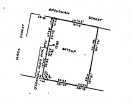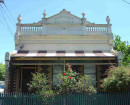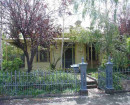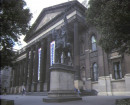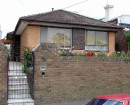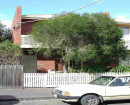Wellington Street
BIGNELL ST, BRIGHTON ST, BRIXTON ST, BRYANT ST, CHURCH ST, DALGLEISH ST, ELTHAM ST, FARNHAM ST, FINSBURY ST, KENT ST, LEE ST, MARWICK ST, LEWIS ST, NORWOOD PL, NORWOOD ST, PIN OAK CR, PRINCES ST, SHIELDS ST, WALTHAM ST and WELLINGTON ST, FLEMINGTON
-
Add to tour
You must log in to do that.
-
Share
-
Shortlist place
You must log in to do that.
- Download report
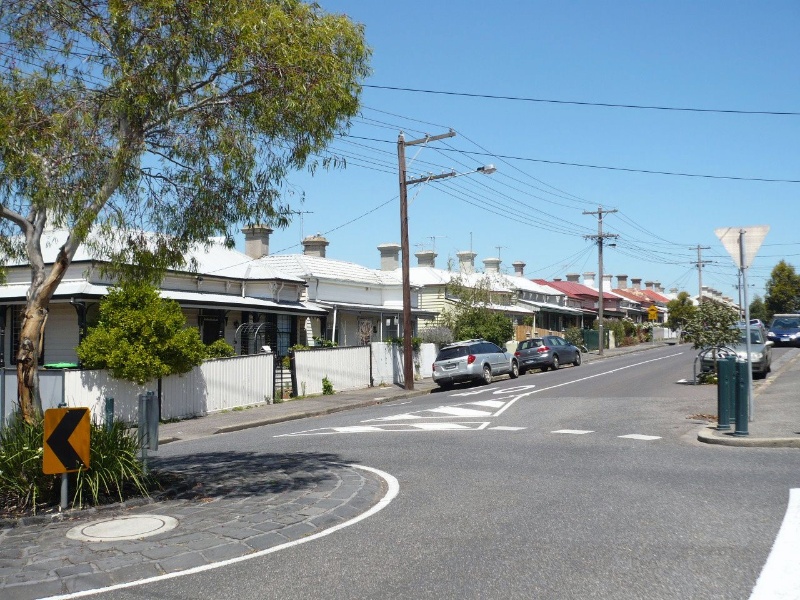

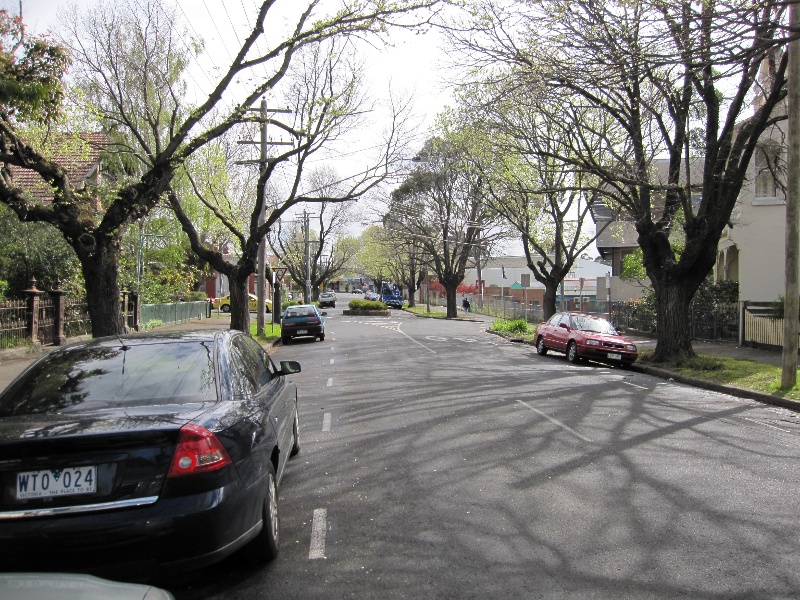
Statement of Significance
What is significant?
The Wellington Street precinct in Flemington was mostly developed in the late nineteenth and early twentieth century with some infill development occuring during the inter-war era. Predominantly residential, it also contains a strip of double and single storey shops along Racecourse Road and part of Pin Oak Crescent, as well as a fine group of community and civic buildings including churchand school complex, and a former courthouse and post office along Wellington Street. The houses include Victorian and Edwardian terrace rows, villas and cottages, interspersed with inter-war houses and bungalows.
The following elements contribute to the significance of the precinct:
1. The houses (and some shops and residences), and any associated early/original front fences, as appropriate at:
- 1 High Street
- 2-12 Bignall Street
- 9-21 & 27-35 and 14-36 & 42-46 Brighton Street
- 1-23 and 2-26 Brixton Street
- 11-23 & 33-45 and 20-28, 32-46, 50-70 & 82-96 Bryant Street
- 7-9 and 2-12, 22-38 Church Street
- 2-24 Dalgleish Street
- 1-41& 2-8 & 16-38 Eltham Street
- 1-23, 31-35, 45, 47, 53-77 and 2-6, 10-46 Farnham Street
- 3-45 & 49 and 2-28 & 34-42 Finsbury Street
- 41-51, 61-73, 77, 79, 81- 85, 89-105 Kent Street
- 1, 3, 9-27& 2-28 Lee Street
- 1-23& 2-24 Marwick Street
- 1-19& 2-14 Lewis Street
- 7 Norwood Place
- 3-25& 2-24 Norwood Street
- 74-162, 186-200, 208-242 & 256-288 Pin Oak Crescent
- 7, 11-15, 37-79, 93-99, 103, 105, 113-133 and 14-20, 22A, 24-70, 76-88 & 92-110 Princes Street
- 1-15, 19, 21, 27, 51-85, 91, 93, 101-111& 10-110 Shields Street
- 1-5, 13, 15, 19-71& 10-46 Waltham Street
- 1-7, 15-47, 51, 63-71, 77, 107-115 & 123-165 and 2-26 & 32-62 Welllington Street
2. The group of civic and community buildings comprising the Flemington Post Office at 2a Wellington Street, former Court House, Police Station & Lock-up at 28-30 Wellington Street, former Masonic temple at 9 Wellington Street, St Brendan's Church complex at 83-103 Wellington Street, Presbyterian Church at 28-40 Norwood Street, the 1896 former Fire Station at 59-61 Wellington Street, and the former Baptist Church at 12 Brighton Street.
3.The shops and residences at:
- 6-22 & 34-72 Pin Oak Crescent
- 262-268, 282, 284, 290-304, 304A, 316, 318 & 324-336 Racecourse Road.
Key attributes that contribute to the significance of this precinct include:
- the consistency of scale (one or two storey), form, siting (uniform or similar front and side setbacks), and original materials and detailing (face brick or render with iron or tiled hip or gable roof, verandah with cast iron or timber detailing) of the contributory residential buildings, which typically survive with a relatively intact presentation to the street.
- the landmark quality of civic and community buildings along Wellington Street, both individually and as a grouping within the precinct.
- the consistency of scale and siting of buildings and the relative intactness of the upper facades within the commercial centre.
- the high degree of intactness to the late nineteenth century and early twentieth century development dates in most streets
- original front fences and low height of fences to residential properties meaning that dwellings are visible from the street
- regular road alignments and allotment patterns resulting from the nineteenth century subdivision
- the absence of vehicle accommodation including driveways and crossovers
- the bluestone kerb and channel in various streets throughout the precinct, bluestone and unmade laneways, and mature street trees including Planes (Platanus sp.) and Elms (Ulmus sp.).
Other houses in the precinct, post-WWII fences, and non-original additions to contributory places (e.g. non-original shopfronts and awnings to shops and rear additions to houses) are not significant.
How is it significant?
The Wellington Street precinct in Flemington is of local historic, architectural and aesthetic significance to the City of Moonee Valley.
Why is it significant?
It is historically significant as an area that illustrates the rapid development of Flemington as a self-contained suburb of Melbourne in the late nineteenth and early twentieth century. The consistency of built form and the extent to which the key phase of development is clearly apparent vividly illustrates the rapid and sustained development in this area during the boom years of the late nineteenth century. The historic importance of this area as the centre of Flemington is demonstrated by the commercial, civic and community buildings, which provide further evidence of the extent of development during the late nineteenth and early twentieth century. (Criterion A & D)
The precinct is socially significant for the extent to which the location of different housing types - generally working class housing in the lower streets (or smaller laneways) such as Victoria Street and Norwood Place with middle and upper class housing on the higher ground - illustrates how the class structure was reflected in the layout and development of suburban Melbourne into the twentieth century. (Criterion G)
It is architecturally and aesthetically significant as an outstanding example of a nineteenth century suburban area, which is which is notable for consistency of built form and the relatively high degree of integrity to the main periods of development. Wellington Street, with its series of landmark civic buildings on key street corners and mature street trees is especially notable as one of the finest nineteenth century streetscapes in the municipality. (Criteria D & E)
-
-
Wellington Street - Physical Description 1
This precinct predominantly comprises residential development, with a commercial strip along Racecourse Road and Pin Oak Crescent, and a notable group of civic and community buildings along Wellington Street. The buildings predominantly date from the late nineteenth century and early twentieth century, reflecting the key phases of development, with a small amount of inter-war infill.
Residential development
The precinct is strongly characterised by Late Victorian housing, although there is considerable variety in form, from humble workers' cottages to elaborate double-storey townhouses. The most common manifestation, however, is modest middle-class single-storey houses of timber or masonry, either as detached villas, semi-detached pairs, or rows. There are numerous double-fronted villas, either with symmetrical or asymmetrical frontages, which occasionally exist in rows (e.g., 112, 114 & 116 Princes). Single-fronted cottages are more often found in rows -freestanding (e.g., 76-84 Princes and 86-98 Shields),or semi-detached pairs (54-56 Princes) or individual examples scattered throughout the precinct.There is also much variety in materials: weatherboard (e.g., 60-70 Princes), block-fronted (112-116 Princes), bi-chromatic brick (35-45 Finsbury), painted brick (26-30 Victoria) or rendered (1-7 Finsbury). They generally have hipped rooves, clad in corrugated galvanized steel or (less commonly) slate. Most retain verandahs, variously with ogee, bull-nosed or skillion rooves supported on cast iron columns, stop-chamfered timber posts or (less commonly) turned timber posts. Some verandahs have been rebuilt with new flat rooves, metal trellises, etc.
Most Victorian houses are relatively unadorned, with simple bracketed eaves or moulded corbels; a small number are more elaborate, with ornate Boom-style parapets. Amongst the more notable examples is Newmarket Terrace at 57-75 Princes Street, a row of ten terraces with a continuous balustraded parapet and shaped pediments, scrollwork and vermiculated panels. Even more impressive is Nathans Terrace at 1-11 Shield Street (and 4-14 Wellington Street), a quirky architect-designed row enlivened with orbs, heraldic motifs, broken pediments and so on. Notable amongst the detached houses is Bolinda at 43 Kent Street, a highly ornamented rendered brick villa with two canted bay windows and a prominent return verandah.
Anomalies include a few simple double-fronted weatherboard villas, only one room deep, with IongitudinaI gabled rooves, skillion additions to the rear, and simple verandahs to the front. These humble houses (e.g., 42 & 44 Princes Street) are amongst the oldest in the area. At the other end of the spectrum are the rows of double-storey terraces, of which there are only a few instances (e.g. 48-54 Shields Street, 84-92 Pin Oak Crescent and 37-11 Eltham Street) and the double storey detached villas. The latter tend to be located to the northern part of the precinct; most are on Wellington Street, namely Nos. 36, 38, 46, 62, and St Brendan's Presbytery, beside the church, at No 103. Other examples survive nearby at 2-4 Church Street and 70 Bryant Street.
Typically, the Edwardian homes are in the form of weatherboard or block-fronted villas with asymmetrical double-fronted facades. These usually have gambrel rooves (clad in corrugated galvanised steel) with gable ends infilled with roughcast render, half timbering or, less commonly, notched weatherboards (e.g., 106, 108 & 110 Princes Street) or pressed metal. Verandahs mostly comprise bullnose rooves on turned timber posts, often with cast iron lace. Chimneys are face red brick, often embellished with roughcast banding, brick corbels or rendered mouldings of sinuous form.
There are also some rows of single-fronted Edwardian cottages, similarly detailed with bullnosed verandahs, turned timber posts, and gabled rooves with roughcast (e.g., 88 & 92 Princes) or pressed metal gables (95, 97 & 99 Princes Street). Far less common are red brick Edwardian houses, which variously exist as terraced rows (e.g., 73-77 Farnham), semi-detached pairs (1-3 & 5-7 Wellington; 10-12 Farnham), less common of all, as detached villas (21 Shields; 41 Kent). The villa at No.41 Kent Street (built c.1912 for local butcher George Allum) is a particularly fine example of the Queen Anne Villa style, with tuck-pointed brickwork, slate roof, rectangular bay window and a distinctive conical corner turret. This house, along with 14 Kent Street, had the first garage in the suburb and is the only one remaining from 1912.
There is only a relatively small number of inter-war houses in the precinct. Most commonly, these are in the form of semi-detached clinker brick maisonettes - occasionally rendered, and often enlivened by banding, quoining or diaper work of Roman and/or tapestry bricks. Examples include 2-4 Farnham Street, 2-4 Eltham Street, 39-31 Bryant Street, 1-3 Dalgleigh Street and 77-77a Shields Street. A number of maisonettes also exist in groups (e.g., 90-94 Bryant, 2-4 Eltham and 120-28 Pin Oak).
The remaining inter-war houses in the precinct tend to be ubiquitous 1920s bungalow-style houses, characterised by roughcast banding, shingled gable ends, curved bay windows, and distinctive porches with tapered rendered pillars, broad arches, columns or brick piers. Almost all are of red brick, although there are a few anomalous weatherboard examples (e.g., 15 & 17 Victoria). Most bungalows are single-storeyed, but there are some with attic storeys, including two in Wellington Street (Nos. 51 & 125) that are particularly large and imposing examples, with more elaborate embellishments such as solomonic columns and hit-and-miss brickwork.
Unlike the maisonettes, which are often found in groups, the bungalows tend to be more isolated, scattered randomly amongst the earlier Victorian and Edwardian houses (e.g. 22a Princes, 63 Waltham, 54 Wellington, 90 Farnham, 33 Eltham, etc.). Uncharacteristically, there is a row of three adjacent bungalows at 43-47 Wellington Street and a row of four at 139-145 Victoria Street.
Commercial development
The precinct also includes a substantial commercial component, concentrated along Racecourse Road and Pin Oak Crescent. The nineteenth century shops are single storeyed (e.g., 28 & 32 Pin Oak) or double storeyed (50-52 & & 70 Pin Oak; 324-330 Racecourse), typically with a rendered finish and ornate parapets enlivened by shaped pediments, scrollwork, balustrades and orbs or urns. Inter-war shops tend to be single storeyed, with simple low brick parapets articulated by capped piers, rendered coping or simple mouldings. A number of shops on Pin Oak Crescent (e.g., Nos. 62-66) still retain original or early shop fronts, with recessed splayed entrances, large metal-framed windows, tiled spandrels and glazed highlights.In addition to the strip shops along Racecourse Road and Pin Oak Crescent, there are a number of individual Victorian shops (mostly no longer used as such) scattered throughout the precinct. Typically located on corners, they are built right to the property line, usually with a verandah extending across the footpath. Some are of weatherboard construction (e.g., 48 & 58 Princes) while others are rendered brick (e.g., 15 Norwood, 65 Wellington, 94 Pin Oak). Some are single fronted (e.g. 26 Brighton), while others take full advantage of their corner sites with return verandahs and the ubiquitous splayed corner entry (e.g., 94 Pin Oak). Many still retain original shop front detailing, such as multi-paned timber-framed shop windows.
Community and civic buildings
Along with the housing and shops, the precinct also contains a number of contemporaneous public buildings of particular note, most located on Wellington Street. These include the remarkable post office (1889), with its conical-roofed tower, the police complex (1891), with its idiosyncratic American Romanesque detailing and onion domes, the nearby fire station (1896), with its distinctive horseshoe arch, and the former Masonic hall at No.9 (date unknown).St Brendan's Roman Catholic Church complex, further north, comprises a fine red brick schoolhouse (1914) with a large Baroque Revival church alongside (1923). Two other churches are discreetly located in side streets: the former Presbyterian church, a small polychrome brick building in Norwood Street which forms part of the surviving portion of the Church complex which was lost in a fire (1889), and the Baptist church, a modest red brick structure in Brighton Street (1905), as well as the original timber church (1880s) and timber hall (c1905) behind it.
Note: Most of the community and civic buildings cited above are of individual heritage significance and have their own place record, which provides further detail.
Heritage Study and Grading
Moonee Valley - Review of HO precincts
Author: David Helms HPM
Year: 2010
Grading: LocalMoonee Valley - City of Moonee Valley Heritage Review 2004
Author: Heritage Alliance
Year: 2004
Grading:
-
-
-
"1890"
 Yarra City
Yarra City -
"AMF Officers" Shed
 Moorabool Shire
Moorabool Shire -
"AQUA PROFONDA" SIGN, FITZROY POOL
 Victorian Heritage Register H1687
Victorian Heritage Register H1687
-
'ELAINE'
 Boroondara City
Boroondara City -
-oonah
 Yarra City
Yarra City -
..eld House
 Yarra City
Yarra City
-
-






